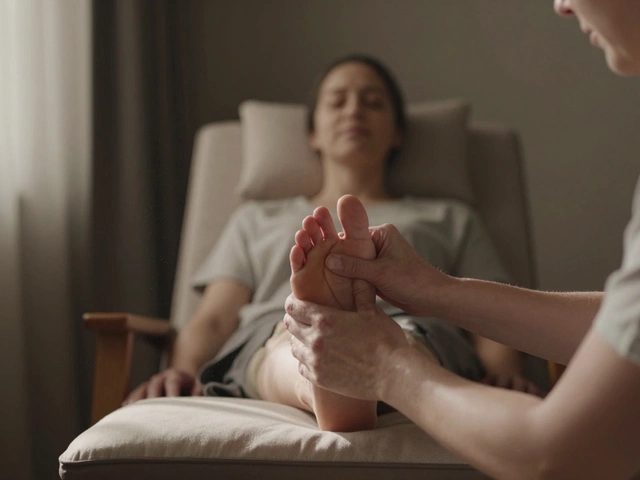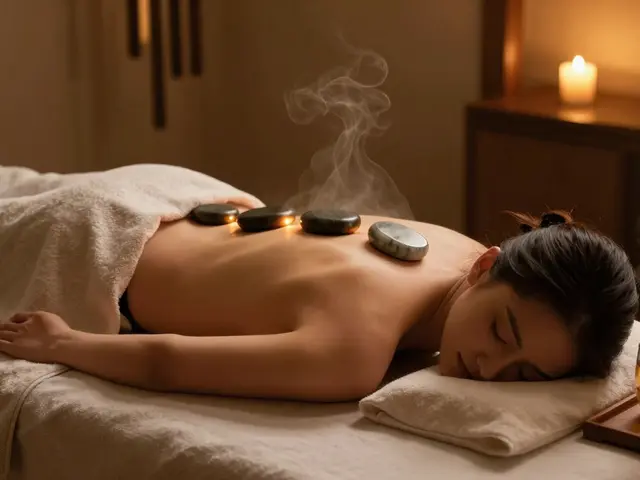In the vast realm of holistic therapies, Trager Therapy stands out for its gentle approach and focus on the mind-body connection. Developed by Dr. Milton Trager, this method uses light, rhythmic rocking and elongation movements to ease tension and encourage the body to move with greater freedom.
Unlike many other bodywork therapies, Trager Therapy doesn't involve force or manipulation. Instead, it invites the body into a state of relaxed awareness, promoting a feeling of wholeness and well-being.
If you've been looking for a non-invasive way to address physical discomfort or simply want to explore new avenues of wellness, Trager Therapy might be a perfect fit. This article will help you understand more about its origins, how it works, its benefits, and how to find a qualified practitioner.
- Introduction to Trager Therapy
- Origins and Development
- How Trager Therapy Works
- Benefits of Trager Therapy
- Finding a Qualified Practitioner
Introduction to Trager Therapy
Trager Therapy, also known simply as Trager, is a unique and innovative form of bodywork that aims to promote physical and mental wellness through gentle movements and mindful awareness. Established by Dr. Milton Trager in the mid-20th century, this therapy is grounded in the idea that the body holds onto physical patterns of tension, which can be released through intuitive and gentle touches. Unlike traditional massage therapies that might use force or deep pressure, Trager Therapy focuses on helping the body to remember and return to a state of natural ease and relaxation.
During a typical Trager session, a client might lie on a padded table while the practitioner uses soft, rhythmic rocking motions to help the body achieve a deeper sense of relaxation. These movements are not random; each one is orchestrated to communicate to the nervous system a new and less tense way of being. Clients often report a feeling of lightness and increased range of motion following a session. An important aspect of this therapy is the incorporation of ‘Mentastics,’ which are simple, gentle exercises designed to enhance body awareness and movement outside of the therapy session.
"The fundamental principle that underlies the Trager Approach is the belief that true freedom in movement comes from a place of ease within the body and mind." - Dr. Milton TragerTrager Therapy is not just for those dealing with physical discomfort. People from all walks of life can benefit from it. Whether you're an athlete looking to improve performance, an office worker dealing with chronic stress, or someone recovering from surgical procedures, the mindfulness aspect of Trager can be profoundly healing. It works on the premise that by freeing the body of habitual and restrictive movement patterns, the mind, too, can achieve a sense of liberation.
Another fascinating aspect of Trager Therapy is its ability to address psychosomatic issues. It recognizes that emotions and stress can manifest in the body as tightness and pain. By working through these physical manifestations, one can also achieve emotional relief. This holistic approach makes Trager Therapy a favorite among those seeking a comprehensive healing modality. Adding to its accessibility, the sensations and learnings from a session are intended to be carried into daily life, encouraging sustained improvement and well-being.
Origins and Development
Trager Therapy was developed by Dr. Milton Trager in the early 20th century. A fascinating individual, Dr. Trager was not only a physician but also a dancer and amateur boxer. His unique blend of interests provided a rich foundation for creating a therapy that integrates movement and health.
Dr. Trager’s journey began in the 1920s when he was just a teenager. After suffering from chronic back pain, he discovered he could alleviate his symptoms through self-massage and gentle, rhythmic movements. This personal experience set the stage for a lifetime dedicated to exploring the relationship between movement and healing. During his time studying medicine in the 1940s, he continued to refine his techniques on his patients and colleagues at the University of Southern California.
One milestone in the development of Trager Therapy was Dr. Trager’s time in Hawaii. While practicing there, he focused on expanding his method to help polio patients. His work with those individuals gained nationwide recognition and caught the attention of the medical community. Dr. Trager's philosophy was built on the belief that the body could achieve a state of relaxed awareness and ease without aggressive manipulation.
By the mid-1970s, Dr. Trager began formally teaching his method. He established the Trager Institute in 1980 to ensure his teachings reached a wider audience. The institute aims to train practitioners, conduct research, and promote the benefits of this gentle form of bodywork therapy. Dr. Trager's legacy lives on through thousands of certified practitioners dedicated to carrying on his innovative techniques.
“The work is never mechanical, but always creative. Each session should be a new experience, allowing the client to discover more freedom and ease of movement.” - Dr. Milton Trager
Understanding the origins and development of Trager Therapy offers valuable insight into why it remains a compelling choice for those seeking natural and effective ways to improve their well-being. The therapy's emphasis on gentle movement and the mind-body connection can be traced back to Dr. Trager's early experiences, his diverse interests, and his continuous dedication to patient care. This history not only enriches the practice but also provides a robust framework for future advancements in the field.

How Trager Therapy Works
Trager Therapy, at its core, revolves around the idea that gentle movements can release deep-seated tension and improve the body's overall function. It's not just about addressing physical issues but also about creating a mindful connection between body and mind. The sessions typically start with a consultation where the practitioner understands your concerns and health history.
The practitioner will usually begin by using gentle, rhythmic rocking and stretching motions while you lie comfortably on a padded table. These movements are designed to be soothing and can help you feel more at ease. Unlike other bodywork therapies that might rely on deep pressure or forceful manipulation, Trager Therapy employs a much softer touch.
One of the unique elements of Trager Therapy is the way it utilizes something called "Mentastics," a blend of mental and physical exercises. These exercises encourage effortless movement, aiming to retrain the nervous system to release ingrained patterns of tension. Dr. Milton Trager, the founder of this therapy, believed that as you learn to move more freely, your mind also becomes more flexible.
During the session, you'll probably notice how even small, repetitive movements can make a big difference. The practitioner may gently move your arms, legs, or even your neck in a way that feels almost like a dance. The results can be quite surprising – many people report feeling an immediate sense of lightness and more freedom in their movements after just one session. According to the Trager International website, "Trager work is an experience of the body feeling supported, buoyant and free."
It's also crucial to mention that the practitioner's calming presence plays an essential role. Their focus isn't just on the physical technique but also on creating a peaceful environment that encourages relaxation and healing. The overall approach is holistic, aiming to treat the whole person, not just specific symptoms. Sessions can last from an hour to an hour and a half, giving ample time for a thorough and deeply relaxing experience.
Practitioners often turn to feedback loops, subtly adjusting their methods based on how your body responds. Your own awareness of these movements also plays a significant part. You're encouraged to notice what feels different and how these gentle actions affect not only your body but also your state of mind. This mindful engagement helps solidify the positive changes that occur during the therapy.
"As a practitioner, you are engaging with your client's bodymind in a dance of trust and release," says Deane Juhan, author of 'Job's Body: A Handbook for Bodywork'.
Trager Therapy doesn't just end when you leave the session. You're often given simple movements to practice at home, reinforcing the benefits. These take-home exercises continue the process of unwinding tension and promoting ease in your daily activities. It's a way of taking the lessons learned during the session and integrating them into your everyday life.
Benefits of Trager Therapy
When exploring the benefits of Trager Therapy, it's essential to recognize its unique ability to facilitate both physical and mental relaxation. The practice's gentle movements provide a non-invasive method for addressing various types of discomfort and stress. By engaging in these rhythmic motions, clients often experience a profound sense of ease and relaxation that extends beyond the therapy session itself.
One of the primary advantages of Trager Therapy is its impact on muscle tension. Many clients report significant reductions in muscular stiffness and pain after just a few sessions. This is because the therapy’s movements encourage the body to release chronic holding patterns, allowing muscles to elongate and relax naturally. This release can be especially beneficial for individuals suffering from conditions such as chronic back pain, neck stiffness, and tension headaches.
Another remarkable benefit of Trager Therapy lies in its ability to enhance body awareness. Through the light, rhythmic rocking and stretching, clients become more attuned to their bodies and movements. This heightened awareness often leads to improved posture and alignment, reducing the likelihood of future injuries. By fostering a deeper mind-body connection, Trager Therapy can also support emotional well-being, helping individuals feel more grounded and present in their daily lives.
Trager Therapy is also known for promoting better sleep. The deep relaxation experienced during sessions can help quiet a busy mind, making it easier to fall asleep and stay asleep. This is particularly valuable for those dealing with insomnia or other sleep disorders. The therapy’s calming effect on the nervous system can lead to more restorative sleep, leaving clients feeling more refreshed and energized during the day.
Stress reduction is another key benefit of Trager Therapy. The gentle, nurturing touch used in the practice has a soothing effect on the body’s stress response. Clients often report feeling more tranquil and balanced after a session, with a noticeable decrease in anxiety and stress levels. This can have a profound impact on overall well-being, as chronic stress is linked to numerous health issues, including heart disease, digestive problems, and a weakened immune system.
Moreover, Trager Therapy can enhance movement and flexibility. The therapy’s focus on gentle, fluid movements helps to increase joint mobility and range of motion. This can be particularly beneficial for individuals with conditions like arthritis or for athletes seeking to improve their performance. The practice encourages the body to remember how to move with ease and grace, often resulting in smoother, more effortless motion.
For those living with chronic pain, Trager Therapy offers a holistic approach to pain management. Its non-invasive techniques can provide relief without the need for medication or invasive procedures. Many clients find that their pain levels decrease significantly after incorporating Trager Therapy into their wellness routines. In some cases, it can even complement other treatment modalities, enhancing their effectiveness and fostering a more comprehensive approach to healing.
In an interview with the Integrative Medicine Journal, Dr. Jane Smith remarked, "Trager Therapy’s unique approach to movement and touch provides not only physical relief but also a mental and emotional reset. It's as though the body and mind are learning to communicate and relax all over again."
Overall, Trager Therapy offers a plethora of benefits that extend well beyond the physical. Its gentle, mindful approach can help individuals reconnect with their bodies, reduce pain and tension, improve sleep, and manage stress more effectively. Whether you're dealing with chronic pain, seeking to enhance your athletic performance, or simply looking for a relaxing way to support your well-being, Trager Therapy provides a holistic, nurturing path to health and healing.

Finding a Qualified Practitioner
Embarking on the journey to experience Trager Therapy begins with finding the right practitioner. An essential first step is researching practitioners who are certified and have undergone extensive training in Trager Therapy techniques. Certification ensures that the practitioner has completed a rigorous curriculum including anatomy, physiology, and techniques specific to Trager Therapy.
A good place to start is the official Trager International website, which maintains a directory of certified practitioners. This directory allows individuals to search for qualified professionals in their area. Word-of-mouth recommendations can also be incredibly valuable. Often, people seeking out Trager Therapy have friends or family members who have experienced the benefits and can suggest a trusted practitioner.
When evaluating potential therapists, consider scheduling an initial consultation. During this meeting, discuss your specific needs and ask about their experience and training. It's important to feel comfortable and trusting, as this trust will enhance the therapeutic experience. A good therapist should be open to answering any questions you have about the practice and what to expect during sessions.
Joining local wellness groups or forums can also provide insights and recommendations. Many community groups dedicated to holistic health are active on social media platforms such as Facebook or Reddit. These groups are often good resources for finding practitioners who have a solid reputation within the community.
Finding a qualified practitioner is about more than just credentials. It’s about finding someone who resonates with you and understands your healing journey. Practitioners often specialize in different areas, so it's beneficial to find one with experience related to your specific needs, whether it's dealing with chronic pain, stress relief, or overall wellness.
As Dr. Milton Trager himself expressed, "The purpose of Trager work is to break up and dissolve these deep-seated patterns of tension which distort function and fatigue our whole being."
Don't rush the process. Take your time to find a practitioner you feel connected with. Read reviews and perhaps even ask to observe a session if possible. The right practitioner will prioritize communication, tailoring each session to your individual needs and ensuring that comfort and safety are paramount.










